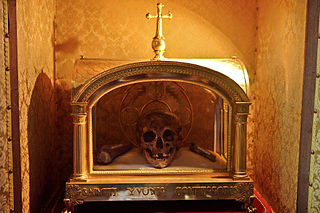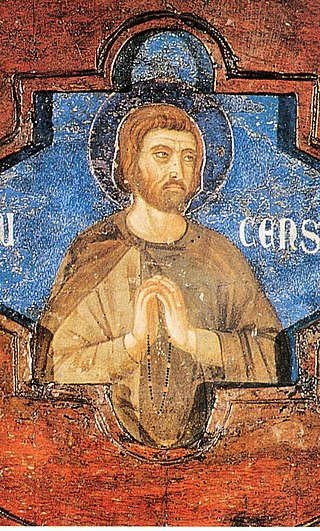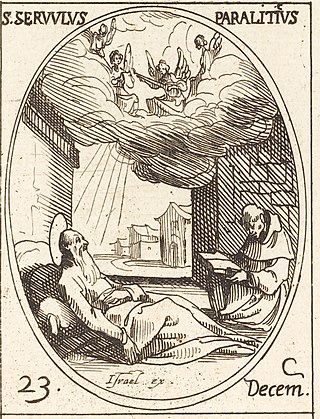Related Research Articles

Benedict of Nursia, often known as Saint Benedict, was an Italian Christian monk, writer, and theologian. He is venerated in the Catholic Church, the Eastern Orthodox Church, the Oriental Orthodox Churches, the Anglican Communion, and Old Catholic Churches. In 1964 Pope Paul VI declared Benedict a patron saint of Europe.

Anthony of Padua, OFM or Anthony of Lisbon was a Portuguese Catholic priest and friar of the Franciscan Order.
Subdeacon is a minor order of ministry for men in various branches of Christianity. The subdeacon has a specific liturgical role and is placed below the deacon and above the acolyte in the order of precedence.

In religion, a relic is an object or article of religious significance from the past. It usually consists of the physical remains or personal effects of a saint or other person preserved for the purpose of veneration as a tangible memorial. Relics are an important aspect of some forms of Buddhism, Christianity, Islam, shamanism, and many other religions. Relic derives from the Latin reliquiae, meaning "remains", and a form of the Latin verb relinquere, to "leave behind, or abandon". A reliquary is a shrine that houses one or more religious relics.

Intercession of the Saints is a Christian doctrine that maintains that saints can intercede for others. To intercede is to go or come between two parties, to plead before one of them on behalf of the other. It is held by the Catholic, Eastern Orthodox, Assyrian Church of the East, and Oriental Orthodox churches, and some Lutherans and Anglicans. The practice of praying to saints for their intercession can be found in Christian writings from the 3rd century onwards.

The raising of the son of the widow of Nain is an account of a miracle by Jesus, recorded in the Gospel of Luke chapter 7. Jesus arrived at the village of Nain during the burial ceremony of the son of a widow, and raised the young man from the dead.

Nimatullah Kassab, O.L.M., also known as "Al-Hardini" in reference to his birth village, was a Lebanese monk, priest and scholar of the Maronite Church. He has been declared a saint by the Catholic Church.

Saint Wendelin of Trier was a hermit and abbot. Although not listed in the Roman Martyrology, his cultus is wide-spread in German-speaking areas. He is a patron of country folk and herdsmen. He is honored on October 22.

Saint Cuthmann of Steyning, also spelt Cuthman, was an Anglo-Saxon hermit and church-builder.

There are a number of episodes in the New Testament in which Jesus was rejected. Jesus is rejected in Judaism as a failed Jewish messiah claimant and a false prophet by all denominations of Judaism.
Hanina ben Dosa was a first-century Jewish scholar and miracle-worker and the pupil of Yohanan ben Zakkai. He is buried in the town of Arraba in the Lower Galilee.

Christian head covering, also known as Christian veiling, is the traditional practice of women covering their head in a variety of Christian denominations. Some Christian women wear the head covering in public worship and during private prayer at home, while others believe women should wear head coverings at all times. Among Oriental and Eastern Orthodox Churches, certain theologians likewise teach that it is "expected of all women to be covered not only during liturgical periods of prayer, but at all times, for this was their honor and sign of authority given by our Lord", while others have held that headcovering should at least be done during prayer and worship. Genesis 24:65 records the veil as a feminine emblem of modesty. Manuals of early Christianity, including the Didascalia Apostolorum and Pædagogus, instructed that a headcovering must be worn by women during prayer and worship as well as when outside the home. When Saint Paul commanded women to be veiled in 1 Corinthians, the surrounding pagan Greek women did not wear headcoverings; as such, the practice of Christian headcovering was countercultural in the Apostolic Era, being a biblical ordinance rather than a cultural tradition. The style of headcovering varies by region, though Apostolic Tradition specifies an "opaque cloth, not with a veil of thin linen".

Luchesius Modestini, TOSF is honored by tradition within the Franciscan Order as being, along with his wife, Buonadonna de' Segni, the first members of the Franciscan Order of Penance, most commonly referred to as the Third Order of St. Francis. He is honored in the Roman Catholic church as a Blessed.

Saint Albinus of Angers, also known as Saint Albin in English, was a French abbot and bishop. Born to a noble Gallo-Roman family at Vannes, Brittany, St. Albinus was a monk and from 504 A.D. Abbot of Tintillac. His reputation spread during the twenty-five years in which he served as abbot. In 529, St. Albinus was elected, against his wishes, Bishop of Angers.

Star Over Bethlehem is an illustrated book of poetry and short stories on a religious theme by crime writer Agatha Christie. It was published under the name "Agatha Christie Mallowan". It was published in the UK by Collins on 1 November 1965 in an edition priced at thirteen shillings and sixpence (13/6) and in the US by Dodd, Mead and Company in an edition retailing at $4.95.
Glodesind (572−608) was a saint, nun, abbess, and founder of a convent in Metz, France, during the time of King Childebert II (575−596) of Austrasia. She was a member of the Carolingian nobility. When she was 11 or 12 years old, she married a young nobleman, who was arrested by the French government shortly after their wedding and executed a year later. Instead of remarrying as her family wanted, she fled to Metz and took refuge at the Church of St. Stephen. Her family gave up forcing her to marry, and she became a nun and later, the abbess of a convent that was built by her parents. She was abbess for six years until her death in 608 at the age of 30. Her feast day is 8 July.
The Spiritual Meadow is a 7th-century book by John Moschus. In Greek, it is titled Neos Paradeisos or Leimōn pneumatikos, in Latin, Pratum spirituale, occasionally abbreviated Prat. Spirit. It is also known as the Sinai Patericon. John Moschus wrote the book during the 610s or 620s. It contains a rich assortment of over 200 narratives, biographies, and collections of sayings.

The raising of the son of the widow of Zarephath is a miracle of the prophet Elijah recorded in the Hebrew Bible, 1 Kings 17, taking place in the Phoenician city of Zarephath.
Saints Maximos and Domadious are saints in the Coptic Orthodox Church.

Saint Servulus was a paralyzed beggar who spent all his time praying outside Saint Clement's Church in Rome. His feast day is 23 December.
References
- ↑ Martyrologium Romanum (Libreria Editrice Vaticana 2001 ISBN 88-209-7210-7)
- ↑ S. Quadragesimus suddiaconus
- ↑ Gregory the Great, Dialogues (1911) Book 3. pp. 105-174